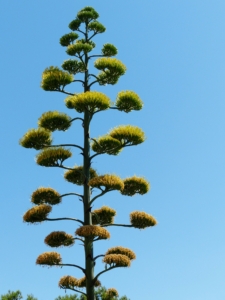Pollination Syndrome
by Heather Stone
Did you know that different kinds of pollinators like certain kinds of flowers and are more likely to visit those flowers? Why is this? As both plants and pollinators have evolved over time certain characteristics or traits have developed to help these plants and pollinators interact more successfully. For plants, this means that pollen collected will be carried to another flower of the same kind and successful reproduction occurs. For pollinators, this means the ability to find and access necessary nectar and pollen resources. Pollination syndrome is defined as suites of flower traits that have evolved in response to natural selection imposed by different pollen vectors, which can be abiotic (wind and water) or biotic, such as animals, birds, bees, flies, moths, beetles and butterflies. There is a collection of characteristics that flowers have evolved to better ensure pollination. These include flower shape, color, odor, nectar, pollen, and the presence or absence of nectar guides.
What kind of flowers do some of our favorite pollinators prefer?
Bees
Bee-pollinated flowers tend to have a lobe that acts as a landing pad for the bee. The flowers reproductive parts are often located at the top of tubular petals, dusting the back of the bee as it enters. Bumblebees have longer tongues than honeybees and are often drawn to deep, tubular flowers. Bees like brightly colored flowers, especially blues and yellows with a light, fresh scent. Bees can not see the color red so will not visit those flowers. Nectar and pollen need to be abundant and nectar guides are present.

Hummingbirds
Hummingbirds can hover while drinking nectar so require no landing pad. These flowers are usually large and funnel-shaped. The flowers anthers dust the top of the hummingbird as it drinks. Red is the preferred color, but they are also attracted to pink and orange colored flowers as well. These flowers usually have little to no scent. Ample nectar supply is important.
Beetles
Beetles prefer a large bowl-shaped flower such as a magnolia. They simply crawl around the flower looking for nectar and in turn, are dusted by pollen. The flower colors are usually white or green and can range in scent from none to overly fruity. Some beetles are also very attracted to flowers with a strong putrid or rotting flesh smell.

Butterflies
Butterflies prefer narrow, tubular flowers with a wide landing pad. They are attracted to brightly colored flowers especially shades of pink, blue, yellow, red and purple with a pleasant floral scent. Ample nectar supply is important and nectar guides are present on these flowers.
Moths
Moths prefer regular or tubular shaped flowers without a lip. These flowers are usually white or dull shades of red, purple or pink. The flowers have a strong scent allowing the moths to locate them at night when they are most active.

Bats
Bats prefer flowers that are regular and bowl-shaped and only open at night when they are feeding. They are usually white, green or purple. These flowers must have an abundant supply of both nectar and pollen.
Flies
What kinds of flowers are flies attracted to? Flies are attracted to those plants with a strong putrid odor resembling the smell of rotten flesh. The flowers are often a purplish color meant to look like the flesh of a rotting animal. They can be shallow and funnel-like or complex and trap-like in shape.


Leave a Reply
Want to join the discussion?Feel free to contribute!